I. Fundamentals
8 Rhythmic and Rest Values
Chelsey Hamm; Mark Gotham; and Bryn Hughes
Key Takeaways
- Notes consist of several different components, including a notehead, stem, beam, and flag.
- Common note values include the whole note, half note, quarter note, eighth note, and sixteenth note.
- Common rest values include the whole rest, half rest, quarter rest, eighth rest, and sixteenth rest.
- British terms for note and rest values are different from American terms.
- A dot increases the duration of a note by half. Subsequent dots add half the duration of the previous dot.
- A tie connects two or more notes of the same pitch. Do not rearticulate any "tied to" notes.
Music is a temporal art—in other words, time is one of its components—so organizing time is essential for Western musical notation. The next several chapters will focus on the temporal facets of rhythm and meter, starting in this chapter with the basic note and rest values in this notation system.
Note Values
Broadly speaking, rhythm refers to the duration of musical sounds and rests in time. As you'll recall in the chapter titled Notation of Notes, Clefs, and Ledger Lines, notes may contain several different components, as seen in Example 1:
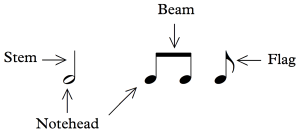
There are many common note values in Western musical notation. Note values are hierarchical; in other words, their lengths are defined relative to one another. Each note value can be divided into two smaller values, as seen in Example 2. Just as a whole pizza divides into two halves, four quarters, eight eighths, etc., a whole note divides into two half notes, four quarter notes, eight eighth notes, and so on.
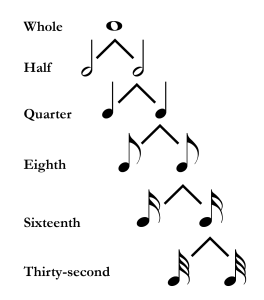
Several additional aspects of Example 2 should be noted:
- Noteheads can be filled in (black) or unfilled (white); quarter notes and shorter durations are filled in.
- Unfilled noteheads may or may not have a stem, but filled noteheads always have stems.
- Flags are only added to the stems of filled noteheads.
Additionally, there are three ways to decrease a note's value by half:
- Adding a stem to a note (i.e., whole to half)
- Filling in a notehead (i.e., half to quarter)
- Adding a flag (i.e., quarter to eighth or eighth to sixteenth)
Open Music Theory privileges the North American names for note values, but it’s worth being familiar with the British names as well (indicated in parentheses below). See Example 2 for a visual of each note value.
- Whole note (semibreve in British English): this thick, unfilled oval shape has no stem. In many compositions today, this is the longest note value used.
- Half note (minim in British English): also an oval, drawn with a slightly thinner line, and has a stem. This note is half as long as the whole note (i.e., two half notes make up one whole note).
- Quarter note (crotchet in British English): looks like the half note, except that the notehead has been filled in. This note is half as long as a half note (i.e., two quarter notes make up one half note) and a quarter as long as a whole note (i.e., four quarter notes make up one whole note).
- Eighth note (quaver in British English): looks like the quarter note, except that a flag has been added to its stem. This note is half as long as a quarter note (i.e., two eighth notes make up one quarter note) and an eighth as long as a whole note (i.e., eight eighth notes make up one whole note).
- Sixteenth note (semiquaver in British English): looks like an eighth note, except that it has an extra flag. This note is half as long as an eighth note (i.e., two sixteenth notes make up one eighth note) and one sixteenth as long as a whole note (i.e., sixteen sixteenth notes make up one whole note).
[table “74” not found /]
Note values shorter than the sixteenth note (thirty-second note, sixty-fourth note, etc.) are created by adding extra flags. You may run into one additional, less common note value called the double whole note (breve in British English; Example 3). Double whole notes are sometimes notated with only one line on either side of the notehead. In older musical notation styles, the notehead appears more square than oval. Double whole notes divide into whole notes (i.e., two whole notes make up one double whole note).
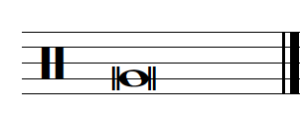
Rest Values
Broadly speaking, rests refer to the duration of silences in music. Each hierarchical note value has a corresponding rest value, as seen in Example 4. Like note values, each rest value can be divided into two smaller values. Several additional aspects of Example 4 should be noted:
- Notice that a whole rest hangs down from a line while a half rest sits on top of a line. It may be helpful to think of a whole rest as “heavier” than a half rest to remember that it hangs down; likewise, a half rest resembles a top hat, so you can think of it as sitting on top of a line as if on a person’s head.
- Practice drawing quarter rests carefully; many students find them difficult to draw.
- Adding a flag to a rest (i.e., eighth to sixteenth) decreases a rest's duration by half.
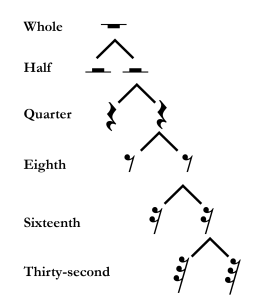
Although rare, you may run across a breve rest (Example 5). A breve rest is equivalent in length to two whole rests. It looks like a filled-in box and appears on the second space from the top.
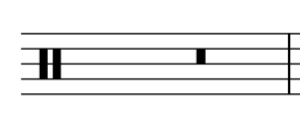
Dots and ties
Dots and ties allow rhythmic and rest durations to be lengthened. A dot is written immediately after a note or rest, and it increases its duration by half (Example 6). For example, a quarter note is equivalent in duration to two eighth notes; therefore, a dotted quarter note would be equivalent to three eighth notes. Similarly, a whole note is equivalent to two half notes, so a dotted whole note would be equivalent to three half notes. Multiple dots can be added to a duration, with each subsequent dot adding half the duration of the previous one. For example, a double-dotted quarter note (i.e., a quarter note with two dots) is equivalent in duration to a quarter note, eighth note, and sixteenth note added together. In other words, a double-dotted note is 1¾ the duration of the original note.
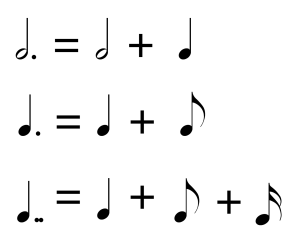
A tie is a curved line that connects two or more notes with the same pitch. Tied-to notes are not rearticulated. In other words, ties are used to combine the durations of multiple notes. The tie connecting the first two notes in Example 7 indicates that, when these half and quarter notes are played or sung, the quarter note should not be articulated; in other words, the first note should be held for the duration of three quarter notes instead of two. Another way to write this duration is as a dotted half note.
https://musescore.com/user/32728834/scores/6805289/s/Qwz0ek/embed
Example 7. A tie connects the first two notes.
You would be correct to think that a tie looks like a slur (see Other Aspects of Notation). The difference between the two is that slurs connect notes of different pitches and indicate to play or sing the notes tenuto, while ties connect notes of the same pitch to create a note with a longer duration.
- Note Durations (musictheory.net)
- Rhythmic Values (learnmusictheory.net)
- Note Values (Essentials of Harmony)
- Dots and Ties (YouTube)
- Dots and Ties (musictheory.net)
- Rhythmic Equations with Whole and Half Notes (.pdf)
- Rhythmic Equations with Half, Quarter, and Eighth Notes (.pdf)
- Rhythmic Equations with Quarter and Eighth Notes (.pdf)
- Rhythmic Equations with Quarter, Eighth, and Sixteenth Notes (.pdf)
- Writing Notes and Rests, Rhythmic Equations, pp. 3–7 (.pdf)
- Advanced Rhythmic Equations, p. 3 (.pdf)
- Slurs and Ties (.pdf)
A musical sound that has both a pitch and a rhythmic component; the symbol may include a stem, beam, and/or flag.
The elliptical part of the note. Can be either filled in (black) or outlined (white).
A vertical line that originates at the notehead, used to indicate rhythm and voicing.
The horizontal lines that connect certain groups of notes together.
A curved line placed at the end of a stem. Each flag added to a stemmed note represents the reduction of the note value by half. For example, the symbol for an eighth note is like a quarter note plus a flag; the eighth note is one-half the value of the quarter note.
A note value that lasts the duration of two half notes. Notation: 𝅝
A note value that lasts half the duration of a whole note, or the duration of two quarter notes. Notation: 𝅗𝅥
A note value that lasts half the duration of a half note, or the duration of two eighth notes. Notation: 𝅘𝅥
A note value that lasts half the duration of a quarter note, or the duration of two sixteenth notes. Notation: 𝅘𝅥𝅮
A note value that lasts half the duration of an eighth note. Notation: 𝅘𝅥𝅯
A type of rest that lasts the duration of two half rests. Notation: 𝄻
A type of rest that lasts half the duration of a whole rest, or the duration of two quarter rests. Notation: 𝄻
A type of rest that lasts half the duration of a half rest, or the duration of two eighth rests. Notation: 𝄽
A type of rest that lasts half the duration of a quarter rest, or the duration of two sixteenth rests. Notation: 𝄾
A type of rest that lasts half the duration of an eighth rest. Notation: 𝄿
Increases a note or rest value by half.
Connects two or more notes of the same pitch; notes after the initial one are not rearticulated.
Relating to time.
The duration of musical sounds and rests in time.
A recurring pattern of accents that occur over time. Meters are indicated in music notation with a time signature.
The relative duration of a note.
Arranged according to rank.
A note value that lasts the duration of two whole notes. Notation: 𝅜
A measured silence in a piece of music.
A curved line placed over notes to indicate that they should be played or sung without separation.
Performed smoothly or connected.

